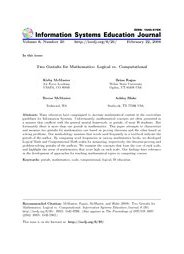Volume 6
Volume 6, Number 20 |
February 22, 2008 |
Abstract: Many educators have campaigned to increase mathematical content in the curriculum guidelines for Information Systems. Unfortunately, mathematical concepts are often presented in a manner that conflicts with the general mental framework, or gestalt, of most IS students. But fortunately there is more than one gestalt in mathematics. This paper attempts to characterize and measure two gestalts for mathematics--one based on proving theorems and the other based on solving problems. Our methodology assumes that words used frequently in a textbook indicate the gestalt of the author. By comparing word frequencies in various mathematics books, we developed Logical Math and Computational Math scales for measuring, respectively, the theorem-proving and problem-solving gestalts of the authors. We examine the concepts that form the core of each scale, and highlight the areas of mathematics that score high on each scale. Our findings have relevance in the development of approaches for teaching mathematical topics in computing courses.
Keywords: gestalt, mathematics, scale, computational, logical, IS education
Download this issue: ISEDJ.6(20).McMaster.pdf (Adobe PDF, 13 pages, 938 K bytes)
Preview the contents: McMaster.c.txt (ASCII txt, 34 K bytes)
Recommended Citation: McMaster, Rague, McMaster, and Blake (2008). Two Gestalts for Mathematics: Logical vs. Computational. Information Systems Education Journal, 6 (20). http://isedj.org/6/20/. ISSN: 1545-679X. (A preliminary version appears in The Proceedings of ISECON 2007: §2342. ISSN: 1542-7382.)
